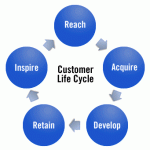“Effective Executive” Series with Kris Duggan, CEO & Co-Founder of Badgeville
This week’s “Effective Executive” interview series is with Kris Duggan, CEO and Co-Founder of Badgeville.
Kris is a serial entrepreneur with a passion for building innovative, fast-growing SaaS companies with thousands of delighted customers. He is dedicated to helping brands on the web increase user engagement by leveraging proven techniques in social gaming and loyalty. A sought-after speaker on gamification, analytics and user engagement, Kris is a thought leader of innovative ways to incorporate game mechanics and social loyalty programs into web and mobile experiences. Prior to founding Badgeville, Duggan worked in leadership roles at a variety of successful companies, including WebEx (a former PerkettPR client), and across a wide variety of verticals.
You have a great deal of expertise in startups. What is it that you love about the startup environment?
I’ve worked in many different companies at this point in my career, from startups I’ve founded or held leadership roles in, to very large, global companies. I have learned a great deal from all of these experiences, but one thing I find most exciting in the startup environment is creating something from nothing. Over the last 20 months, with the help of an extremely talented and intelligent team, we have built a healthy global business with nearly 200 customers and 75 employees. There is nothing more exhilerating, fun and fulfilling than being part of this journey. I also really enjoy building a company from the ground up – defining the culture and team, and being a part of the larger product vision.
Gamification appears to be a solid solution to improving customer loyalty and employee performance. Can you explain how Badgeville is leading the way in this effort?
Gamification for business is a strategy based on game mechanics to help measure and influence user behavior. With the proper psychological application for each audience, these techniques can drive behavior 20 to more than 200 percent. Badgeville is the global gamification leader, with nearly 200 customers across the globe, including Deloitte, EMC, Autodesk, VMware, Symantec, Bell Media, Interscope Records, Opower, Barnes & Noble, and more.
How is Badgeville leading the way in this effort? One of the main reasons customers tell us that they choose Badgeville is our unique view on gamification as part of a larger engagement strategy. We offer a full spectrum of engagement mechanics, including game mechanics, reputation mechanics and social mechanics. Instead of offering gamification for siloed applications, we offer a true Behavior Platform. This means that down to the way our platform database is architected using NoSQL, we are able to integrate our platform across multiple websites, mobile apps, and enterprise applications owned by a company.
This architecture design is extremely important for us, as large businesses don’t want to reward user behavior in one small area of their online experience – they are looking for a holistic gamification program across their online communities, websites, blogs, mobile experiences, CRM systems, training applications, support programs, and other digital experiences. The ultimate value of gamification lies in being able to connect the behavior dots between all of these disparate applications, and this is unique to Badgeville in the market. We like to call this “portable reputation” – where the user experience can tie together all of these online experiences. For the business, there is also the value of having this connectivity from a data perspective, being able to easily identify trends and insights around user behavior across their entire digital ecosystem.
What do you think is driving the rise of social gaming?
Gaming is nothing new. Social media enabled gaming companies to create new types of games which are largely tied to reputation. Instead of playing games by oneself or with a few friends, success in these social games can be viewed by many friends and online peers. This is the same concept used to inspire many behaviors with gamification. Another key factor in the success of social gaming is the rise of mobile technologies. Now game devices are in everyone’s hand. People have a few minutes of spare time in between their busy lives and they want to be able to get entertainment on the train or during a free moment. This is changing the types of games we play. Now, the important part of gameplay is being able to participate for a quick minute or two, and truly engage with this experience, and to come back later to engage even more.
Can you tell us a little bit about the recent launch of Social Mechanics?
Integrating Badgeville’s Behavior Platform begins with tracking important user behaviors. With Game Mechanics and Reputation Mechanics, customers can use the Behavior Platform to reward users for performing these high-value behaviors. With Social Mechanics, we take the behaviors we are tracking and surface them in ways that you may typically see in a social network. For example, our customers can use Social Mechanics to add real-time notifications, live activity streams, and even user-to-user or user-to-topic following. This enables every online experience to have the same social engagement qualities of today’s top social networks. When Game Mechanics or Reputation Mechanics are added to Social Mechanics, the experience is extremely powerful and engaging. The more social an experience is, the more value social rewards and status within that community will be for the user – and the greater the success of the gamification program one will see.
How do you explain your job to your children?
My two sons have a very good understanding of gamification. They would explain it as “making things more fun and engaging.” I’ve gamified a lot of experiences as a parent. When I was coaching T-ball it was hard to get the team of 20 kids motivated… they were more interested in jumping around on top of each other than paying attention to learning how to improve their game. I started to use points to help the kids focus. I created a whole points system where if you caught the ball you get a point, and soon found out the more points catching the ball was worth, the harder the kids tried to catch it. The points were never worth anything, but just adding a point value to the experiences made them try that much harder. The T-ball gamification got increasingly sophisticated. I added virtual rewards like a treasure chest or virtual space shuttle for catching, hitting the ball, and so on. I’ve never seen them work so hard. Gamification is part of everyday life for my kids, so it’s not hard to explain the core concepts to them.
You have traveled extensively. Do you have any memorable trips or spots you would like to share?
I’ve traveled to over 35 countries around the world and have had some very memorable moments… such as visiting the Pyramids of Giza and staying on a houseboat in Kashmir, India for a month. But most recently, the most interesting moment that stuck out in my mind related to gamification was an experience I had on my visit to Japan for the Japanese Gamification Summit. In Japan, aspects of the culture are heavily focused on gaming. When I visited a standard mens restroom, I found a completely gamified urinal. I’m not kidding. Without getting into to many details, there were many options to play this game and win. I thought that was pretty incredible, so I decided to investigate this product further. It turns out it’s made by Sega and it’s call the “Toylet.” We’re actually working on having one special ordered for us to have at the Badgeville headquarters, with some special Badgeville ads and games built into the machine.
What is next for Badgeville for the remainder of 2012?
Badgeville is growing at a very rapid pace. We recently raised our Series C round of funding in under two years of our business launch. This funding is being dedicated directly to product innovation and team growth. This September, we will move to our fifth office in two years with 25,000 square feet for long-term growth. Our employees enjoy “leveling up” each time we move to a new space. Beyond the move, we are constantly working on new products and overall growth. Hiring is a major focus of ours as we continue to seek out top talent in our Silicon Valley, New York and European offices, as well as among our regional teams around the world. We are also fast expanding our global partner network, with emphasis on System Integrators, ISV/OEM partnerships, Agencies, and VARs.
In addition, our inaugural Summit — Engage 2012 — which occurred August 8-9, was a huge project for us — our first two-day event featuring customer stories, key industry analysts and gamification workshops led by our team of expert game designers and producers. We have a lot of photos to share from this great event, here.
.


 Diane Schwartz of
Diane Schwartz of  The rules of search have changed. In fact, they change on a daily basis. Experts say social media’s influence on driving business via the web is expected to surpass search engine optimization (SEO). So, how can you use social media to increase your SEO rank and ensure that the rank and ensuing traffic will convert to web business? Jasmine Sandler of
The rules of search have changed. In fact, they change on a daily basis. Experts say social media’s influence on driving business via the web is expected to surpass search engine optimization (SEO). So, how can you use social media to increase your SEO rank and ensure that the rank and ensuing traffic will convert to web business? Jasmine Sandler of  Every business knows about social media, and today most businesses have some sort of social media presence — but Steve Nichols at
Every business knows about social media, and today most businesses have some sort of social media presence — but Steve Nichols at  The ever-changing and informal nature of social media promotes witty tweets and in-depth discussions on Facebook, but as Matthew Hibbard reports
The ever-changing and informal nature of social media promotes witty tweets and in-depth discussions on Facebook, but as Matthew Hibbard reports  Video is the undisputed darling of the marketing world in 2012. There are a variety of reasons web-based video is such an important media vehicle, and marketers that understand the nuances will be more successful than the laggards. To get started, Kent Lewis of
Video is the undisputed darling of the marketing world in 2012. There are a variety of reasons web-based video is such an important media vehicle, and marketers that understand the nuances will be more successful than the laggards. To get started, Kent Lewis of  Social media, although a relatively recent phenomenon, has become an increasingly more important part of marketing and client base development platform for businesses. What could once be accomplished by a traditional website now needs to be supplemented by a robust and responsive utilization of the tools social media offers. Forbes contributor Jessica Bosari explains
Social media, although a relatively recent phenomenon, has become an increasingly more important part of marketing and client base development platform for businesses. What could once be accomplished by a traditional website now needs to be supplemented by a robust and responsive utilization of the tools social media offers. Forbes contributor Jessica Bosari explains  This week’s “Effective Executives” interview is with
This week’s “Effective Executives” interview is with  Most forms of marketing and advertising focus on attracting and engaging customers through a sales cycle to create awareness and interest, guiding the customer to consider and purchase. Lee Odden writes on
Most forms of marketing and advertising focus on attracting and engaging customers through a sales cycle to create awareness and interest, guiding the customer to consider and purchase. Lee Odden writes on  If your brand has a social media presence, consumers need to hear from you.
If your brand has a social media presence, consumers need to hear from you. 
